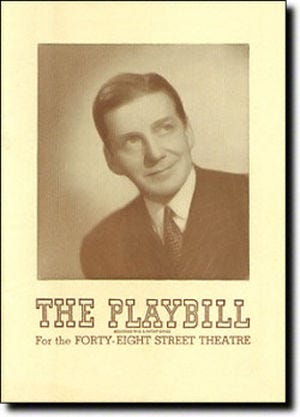FABLED AND FORGOTTEN FRANK FAY
September 25, 2016: Theatre Yesterday and Today, by Ron Fassler
While looking up notable events that occurred on this date in show business history, I stumbled upon the death of Frank Fay in 1961. Now unless you’re in your eighties or nineties this name will mean nothing, as Fay’s major accomplishments were mostly on the vaudeville stage, and therefore rarely recorded. Though he began to find a footing in early 1930s “talkies,” any further stardom was halted when he squandered the good will afforded him with misbehaviors of the most unforgiving kind. Bitter and hopelessly drunk, the last fifteen years of his life were spent friendless, abandoned by all he once knew. He was at one time, however, considered the comedian’s comedian. In fact, he is credited as the man who invented stand-up comedy (even if Bob Hope gets the notoriety of perfecting it into an art form). He was also one of the most hated men in show business. As his fellow comedian (and sworn enemy) Milton Berle once said, “Fay’s friends could be counted on the missing arm of a one-armed man.” An unrepentant fascist and anti-semite, he alienated just about everyone in the uncommonly liberal and overwhelmingly Jewish film and television industry.

At the height of his fame, and in the weeks before the stock market crash of 1929, Fay was making $18,000 a week. He was the most sought after talent in all of vaudeville, mainly due to his having invented a spot for himself where he ruled for a few years as top of the heap. Before Fay, there was no such thing as a host, or master of ceremonies, and it is how he placed something of an immortal footprint. Fay was inordinately comfortable in front of an audience, building up enormous good will due to his ability to connect almost one-on-one in an effortless way. In the old days, a comedian had to play the clown and utilize props and outlandish costumes to get laughs. Even Charlie Chaplin, considered to have been one of the funniest people to ever appear on stage, applied eyebrows and mustache, wore baggy pants and carried a cane, all to adopt a comedic persona. Fay could stand alone on stage (no partner or “straight man” to play off of) and charm his audiences into submission. As the expression goes, “He would have them eating out of the palm of his hand.” Fay’s natural gifts were honed in such a way that he even gave such a great stand-up as Jack Benny pause. If you watch Benny in old vaudeville shorts or on his television program, he always had to resort to stuffing his hands in his pockets, or later in life, to carrying a small, square billiard chalk on stage, twirling it over and over so as to give himself something to do with his hands. But not Fay. Benny’s friend and fellow comedian, George Burns, for years after Fay’s name no longer meant anything to audiences, would explain to interviewers like Johnny Carson that “Frank Fay had the best hands in show business.”
Smart in ways that counted, Fay saw the coming of the end of vaudeville earlier than most, and so developed his stand-up into something he could do on his own. Up until then, comedians hoping to “play the Palace,” then considered the pinnacle, were beholden to every producer on the vaudeville circuit to build up their credits and star power in order to play the big time. Fay figured out a way to bypass them and went straight to the consumer. He was his own industry.
Writing about Fay on his website Travelanche!, Trav S.D. a writer and performer devoted to keeping old vaudeville tales alive, states: “Fay was charming, dashing, and impeccably dressed, with a broad handsome Irish face something like the actor Ralph Fiennes. He had a very distinctive, swishy style of walking that was almost effeminate, but it was so effective that both Bob Hope and Jack Benny emulated it to their dying day.”
Another website, though loaded with information, is not exactly the sort of information you might expect to come across. The first thing notable is its title: “The Fascist Stand-Up Comic.” Quoting comedy writer Milt Josefsberg, it states: “In a business known for its lack of bigotry, he was a bigot. No one liked him, but an unknown actress named Barbara Stanwyck did and, in 1928, she married him. This was before she became one of filmdom’s most beloved leading ladies. When her stardom finally arrived, the joke about Fay was both reasonable and true:
Q: Which Hollywood actor has the biggest prick?
A: Barbara Stanwyck.
It was also this relationship with Fay that sowed the seeds of one of Hollywood’s most filmed stories: that of the star actor who sees his wife eclipse him as the more famous of the two. Though often attributed to other such pairings, there is more than enough truth to substantiate that at least the first filmed version of A Star is Born in 1936, took the ill-fated Fay-Stanwyck marriage as a leaping-off point.
In 1944, down in the dumps and virtually unemployable due to the death of vaudeville as well as his dependency on alcohol, one of the few women directors in the business, Antoinette Perry, took a chance on the faded Fay as the leading man of a new comedy she was bringing to Broadway. Perry, forever to have her name associated as the “Tony” of the Antoinette Perry Awards, insisted that Fay was the only one to portray Elwood P. Dowd in Mary Chase’s Harvey. As an amiable drunk who befriends a 6' 2" tall invisible rabbit, the role fit Fay to a “T.” And after years in oblivion, Fay was welcomed back to the New York stage where he once enjoyed unparalleled success. Harvey went on to become (to this day) one of the longest-running plays in Broadway history, and Fay played it there and on tour for nearly four years. But ultimately it wasn’t enough to save Fay from himself.

Fay relished his rediscovered fame, but abused his star power when he helped organize a rally at Madison Square Garden in January, 1946. It was an event called “The Friends of Frank Fay,” which included members of the Ku Klux Klan and the American Nazi party employed as speakers to talk about the “Jewish influence” of America’s “Communist President Franklin D. Roosevelt.” To hold such a rally a mere six months after the victory of the defeat of Germany and Japan after four long years at war, was stupidity at best and insanity at its worst. Backfiring on Fay in every way possible, he never worked again.
When he died in Santa Monica in 1961 at the age of sixty-nine, he was ostensibly unloved and unmourned. And although I had always read of George Burns admiration for him, in researching Fay for this column, I began to suspect that if I dug a bit deeper, I might discover that Burns found him one of the “deplorables,” much like everyone else seemed to. So for the last word on Fay, here’s George Burns:
“Fay hated Jews, but he was very religious. He used to eat at the Brown Derby and I used to watch. Just before his food came, I would sit down and start to mention people that are dead. I’d say, ‘Tom Fitzpatrick isn’t with us any more.’ He’d bless him and say a prayer. I’d mention five or six more people, and when his food got cold, I’d leave.”
Follow me on Medium, and if you are interested in additional essays as well as information about my upcoming book, “Up in the Cheap Seats,” please visit my website:http://www.ronfassler.org/
